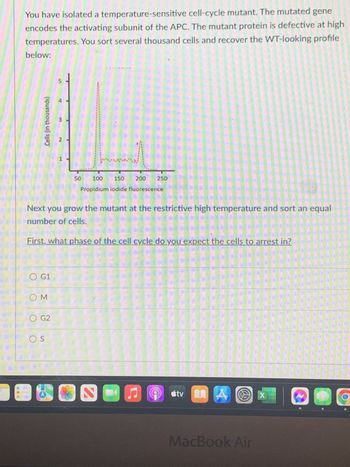
Human Anatomy & Physiology (11th Edition)
11th Edition
ISBN: 9780134580999
Author: Elaine N. Marieb, Katja N. Hoehn
Publisher: PEARSON
expand_more
expand_more
format_list_bulleted
Question
Draw and upload profile for the cells sorted at the restrictive temperature label the axes

Transcribed Image Text:You have isolated a temperature-sensitive cell-cycle mutant. The mutated gene encodes the activating subunit of the APC. The mutant protein is defective at high temperatures. You sort several thousand cells and recover the WT-looking profile below:
*Graph Explanation:*
The graph is a plot of cell counts (in thousands) against propidium iodide fluorescence. The x-axis represents propidium iodide fluorescence, ranging from 50 to 250. The y-axis represents the number of cells, with values ranging from 0 to 5 (in thousands). The graph shows two peaks: a large peak at approximately 100 fluorescence units, and a smaller one near 200 fluorescence units.
Next, you grow the mutant at the restrictive high temperature and sort an equal number of cells.
First, what phase of the cell cycle do you expect the cells to arrest in?
- ○ G1
- ○ M
- ○ G2
- ○ S
Expert Solution
This question has been solved!
Explore an expertly crafted, step-by-step solution for a thorough understanding of key concepts.
Step by stepSolved in 2 steps

Knowledge Booster
Learn more about
Need a deep-dive on the concept behind this application? Look no further. Learn more about this topic, biology and related others by exploring similar questions and additional content below.Similar questions
- What is the purpose of sheath fluid in a flow cytometer? Please answer with 5 dot points/sentences minimumarrow_forwardOrder: IV 0.9% NS 500mL bolus over 4hrs. If you start this bolus IV at 1730h on an infusion pump, how much will be left in the bag at 1900h change of shift? Paragraph B I + v Insert Stuffarrow_forwardOption choices are second photoarrow_forward
- Options for blank one= positive or neg Blank to= into or out of Blank three= negative or positive Blank 4= into or out of Blank 5= equal to or greater thann or less than Blank 6= more negative than or les positive than or more positive then or less negative thenarrow_forwardrogress Which of the following is the base component of the blood buffer? H₂CO3 OHCO3 O H₂PO4 H₂PO4 Q Search 新鮮 "de %6 5 to A- C "4+ 6 a hp &arrow_forwardAnswer all pf the questions thanksarrow_forward
- how to control covid 19 pandamic? need answer in 30 minarrow_forwardBriefly define the factors that affecting evaporation? Please answer at your own easy words.arrow_forwardConsider a P20 micropipette. If the three digits are 185 from top to bottom, what volume would be transferred ? Would that be a safe volume to transfer with this P20 ?arrow_forward
arrow_back_ios
arrow_forward_ios
Recommended textbooks for you
 Human Anatomy & Physiology (11th Edition)BiologyISBN:9780134580999Author:Elaine N. Marieb, Katja N. HoehnPublisher:PEARSON
Human Anatomy & Physiology (11th Edition)BiologyISBN:9780134580999Author:Elaine N. Marieb, Katja N. HoehnPublisher:PEARSON Biology 2eBiologyISBN:9781947172517Author:Matthew Douglas, Jung Choi, Mary Ann ClarkPublisher:OpenStax
Biology 2eBiologyISBN:9781947172517Author:Matthew Douglas, Jung Choi, Mary Ann ClarkPublisher:OpenStax Anatomy & PhysiologyBiologyISBN:9781259398629Author:McKinley, Michael P., O'loughlin, Valerie Dean, Bidle, Theresa StouterPublisher:Mcgraw Hill Education,
Anatomy & PhysiologyBiologyISBN:9781259398629Author:McKinley, Michael P., O'loughlin, Valerie Dean, Bidle, Theresa StouterPublisher:Mcgraw Hill Education, Molecular Biology of the Cell (Sixth Edition)BiologyISBN:9780815344322Author:Bruce Alberts, Alexander D. Johnson, Julian Lewis, David Morgan, Martin Raff, Keith Roberts, Peter WalterPublisher:W. W. Norton & Company
Molecular Biology of the Cell (Sixth Edition)BiologyISBN:9780815344322Author:Bruce Alberts, Alexander D. Johnson, Julian Lewis, David Morgan, Martin Raff, Keith Roberts, Peter WalterPublisher:W. W. Norton & Company Laboratory Manual For Human Anatomy & PhysiologyBiologyISBN:9781260159363Author:Martin, Terry R., Prentice-craver, CynthiaPublisher:McGraw-Hill Publishing Co.
Laboratory Manual For Human Anatomy & PhysiologyBiologyISBN:9781260159363Author:Martin, Terry R., Prentice-craver, CynthiaPublisher:McGraw-Hill Publishing Co. Inquiry Into Life (16th Edition)BiologyISBN:9781260231700Author:Sylvia S. Mader, Michael WindelspechtPublisher:McGraw Hill Education
Inquiry Into Life (16th Edition)BiologyISBN:9781260231700Author:Sylvia S. Mader, Michael WindelspechtPublisher:McGraw Hill Education

Human Anatomy & Physiology (11th Edition)
Biology
ISBN:9780134580999
Author:Elaine N. Marieb, Katja N. Hoehn
Publisher:PEARSON

Biology 2e
Biology
ISBN:9781947172517
Author:Matthew Douglas, Jung Choi, Mary Ann Clark
Publisher:OpenStax

Anatomy & Physiology
Biology
ISBN:9781259398629
Author:McKinley, Michael P., O'loughlin, Valerie Dean, Bidle, Theresa Stouter
Publisher:Mcgraw Hill Education,

Molecular Biology of the Cell (Sixth Edition)
Biology
ISBN:9780815344322
Author:Bruce Alberts, Alexander D. Johnson, Julian Lewis, David Morgan, Martin Raff, Keith Roberts, Peter Walter
Publisher:W. W. Norton & Company

Laboratory Manual For Human Anatomy & Physiology
Biology
ISBN:9781260159363
Author:Martin, Terry R., Prentice-craver, Cynthia
Publisher:McGraw-Hill Publishing Co.

Inquiry Into Life (16th Edition)
Biology
ISBN:9781260231700
Author:Sylvia S. Mader, Michael Windelspecht
Publisher:McGraw Hill Education